Study of the Static and Microwave Magnetic Properties of Nanostructured BaFe12−xTixO19
Abstract
:1. Introduction
2. Materials and Methods
3. Results and Discussion
3.1. X-ray Difraction and Chemical Composition
3.2. Magnetic Properties
3.3. Microwave Properties
4. Conclusions
Author Contributions
Funding
Conflicts of Interest
References
- Iakubov, I.T.; Lagarkov, A.N.; Osipov, A.V.; Maklakov, S.A.; Rozanov, K.N.; Ryzhikov, I.A.; Starostenko, S.N. A laminate of ferromagnetic films with high effective permeability at high frequencies. AIP Adv. 2014, 4, 107143. [Google Scholar] [CrossRef]
- Sai, R.; Shivashankar, S.A.; Yamaguchi, M.; Bhat, N. Magnetic nanoferrites for RF CMOS: Enabling 5G and beyond. Electrochem. Soc. Interface 2017, 26, 71–76. [Google Scholar] [CrossRef] [Green Version]
- Harris, V.G.; Geiler, A.; Chen, Y.; Yoon, S.D.; Wu, M.; Yang, A.; Chen, Z.; He, P.; Parimi, P.V.; Zuo, X.; et al. Recent advances in processing and applications of microwave ferrites. J. Magn. Magn. Mater. 2009, 321, 2035–2047. [Google Scholar] [CrossRef]
- Harris, V.G. Modern Microwave Ferrites. IEEE Trans. Magn. 2012, 48, 1075–1104. [Google Scholar] [CrossRef]
- Yu, Ch.; Sokolov, A.S.; Kulik, P.; Harris, V.G. Stoichiometry, phase, and texture evolution in PLD-grown hexagonal barium ferrite films as a function of laser process parameters. J. Alloy. Compd. 2020, 814, 1–8. [Google Scholar] [CrossRef]
- Harris, V.G.; Sokolov, A.S. The self-biased circulator: Ferrite materials design and process considerations. J. Supercond. Nov. Magn. 2019, 32, 97–108. [Google Scholar] [CrossRef]
- Lagarkov, A.N.; Rozanov, K.N. High-frequency behavior of magnetic composites. J. Magn. Magn. Mater. 2009, 321, 2082–2092. [Google Scholar] [CrossRef]
- Han, M.; Rozanov, K.N.; Zezyulina, P.A.; Wu, Y.-H. Effects of eddy current and dispersion of magnetic anisotropy on the high-frequency permeability of Fe-based nanocomposites. J. Magn. Magn. Mater. 2015, 383, 114–119. [Google Scholar] [CrossRef]
- Li, Q.; Chen, Y.; Harris, V.G. Particle-size distribution modified effective medium theory and validation by magneto-dielectric Co-Ti substituted BaM ferrite composites. J. Magn. Magn. Mater. 2018, 453, 44–47. [Google Scholar] [CrossRef]
- Smit, J.; Wijn, H.P.J. Ferrites; N.V. Philips’ Gloeilampenfabrieken: Eindhoven, The Netherlands, 1959; pp. 202–287. [Google Scholar]
- Pullar, R.C. Hexagonal ferrites: A review of the synthesis, properties and applications of hexaferrite ceramics. Prog. Mater. Sci. 2012, 57, 1191–1334. [Google Scholar] [CrossRef]
- Li, Z.W.; Chen, L.F.; Ong, C.K. Studies of static and high-frequency magnetic properties for M-type ferrite BaFe12−2xCoxZrxO19. J Appl. Phys. 2002, 92, 3902–3907. [Google Scholar] [CrossRef] [Green Version]
- Sugimoto, S.; Okayama, K.; Ota, H.; Kimura, M.; Yoshida, Y.; Nakamura, H.; Book, D.; Kagotani, T.; Homma, M. Effect of substitutional elements on the natural resonance frequency of barium M-type ferrite. J. Magn. Soc. Jpn. 1999, 23, 611–613. [Google Scholar] [CrossRef] [Green Version]
- Yang, A.; Chen, Y.; Chen, Z.; Vittoria, C.; Harris, V.G. Magnetic and atomic structure parameters of Sc-doped barium hexagonal ferrites. J Appl. Phys. 2008, 103, 07E511. [Google Scholar] [CrossRef]
- Kong, L.B.; Li, Z.W.; Liu, L.; Huang, R.; Abshinova, M.; Yang, Z.H.; Tang, C.B.; Tan, P.K.; Deng, C.R.; Matitsine, S. Recent progress in some composite materials and structures for specific electromagnetic applications. Int. Mater. Rev. 2013, 58, 203–259. [Google Scholar] [CrossRef]
- Kittel, C. On the theory of ferromagnetic resonance absorption. Phys. Rev. 1948, 73, 155–161. [Google Scholar] [CrossRef]
- Li, Z.W.; Chen, L.; Ong, C.K. High-frequency magnetic properties of W-type barium–ferrite BaZn2−xCoxFe16O27 composites. J. Appl. Phys. 2003, 94, 5918–5924. [Google Scholar] [CrossRef]
- Rozanov, K.N.; Li, Z.W.; Chen, L.F.; Koledintseva, M.Y. Microwave permeability of Co2Z composites. J. Appl. Phys. 2005, 97, 013905. [Google Scholar] [CrossRef]
- Trukhanov, A.V.; Trukhanov, S.V.; Kostishyn, V.G.; Panina, L.V.; Korovushkin, V.V.; Turchenko, V.A.; Vinnik, D.A.; Yakovenko, E.S.; Zagorodnii, V.V.; Launetz, V.L.; et al. Correlation of the atomic structure, magnetic properties and microwave characteristics in substituted hexagonal ferrites. J. Magn. Magn. Mater. 2018, 462, 127–135. [Google Scholar] [CrossRef]
- Petrov, D.A.; Rozanov, K.N.; Koledintseva, M.Y. Influence of higher-order modes in coaxial waveguide on measurements of material parameters. In Proceedings of the 2018 IEEE Symposium on Electromagnetic Compatibility, Signal Integrity and Power Integrity (EMC, SI & PI), Long Beach, CA, USA, 30 July–3 August 2018; pp. 66–70. [Google Scholar]
- Grössinger, R. A critical examination of the law of approach to saturation. I. Fit procedure. Phys. Status Solidi 1981, 66, 665–674. [Google Scholar] [CrossRef]
- Han, M.; Ou, Y.; Chen, W.; Deng, L. Magnetic properties of Ba-M-type hexagonal ferrites prepared by the sol–gel method with and without polyethylene glycol added. J. Alloy. Compd. 2009, 474, 185–189. [Google Scholar] [CrossRef]
- Vinnik, D.A.; Zhivulin, V.E.; Starikov, A.Y.; Gudkova, S.A.; Trofimov, E.A.; Trukhanov, A.V.; Trukhanov, S.V.; Turchenko, V.A.; Matveev, V.V.; Lahderanta, E.; et al. Influence of titanium substitution on structure, magnetic and electric properties of barium hexaferrites BaFe12−xTixO19. J. Magn. Magn. Mat. 2020, 498, 166117. [Google Scholar] [CrossRef]
- Almessiere, M.A.; Slimani, Y.; Baykal, A. Exchange spring magnetic behavior of Sr0.3Ba0.4Pb0.3Fe12O19/(CuFe2O4)x nanocomposites fabricated by a one-pot citrate sol-gel combustion method. J. Alloys Compd. 2018, 762, 389–397. [Google Scholar] [CrossRef]
- Adenot, A.L.; Acher, O.; Taffary, T.; Longuet, L. Sum rules on the dynamic permeability of hexagonal ferrites. J. Appl. Phys. 2002, 91, 7601–7603. [Google Scholar] [CrossRef]
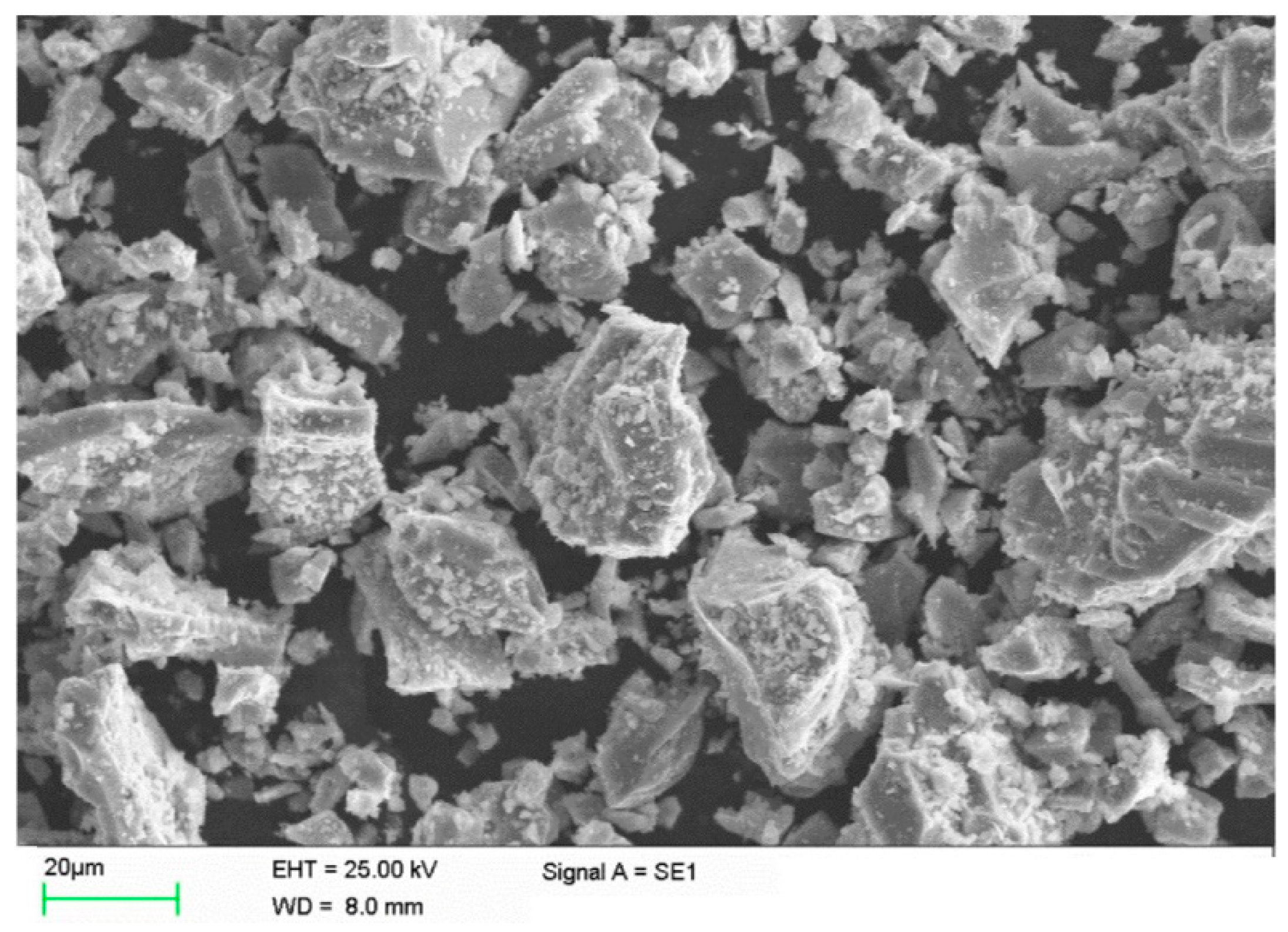
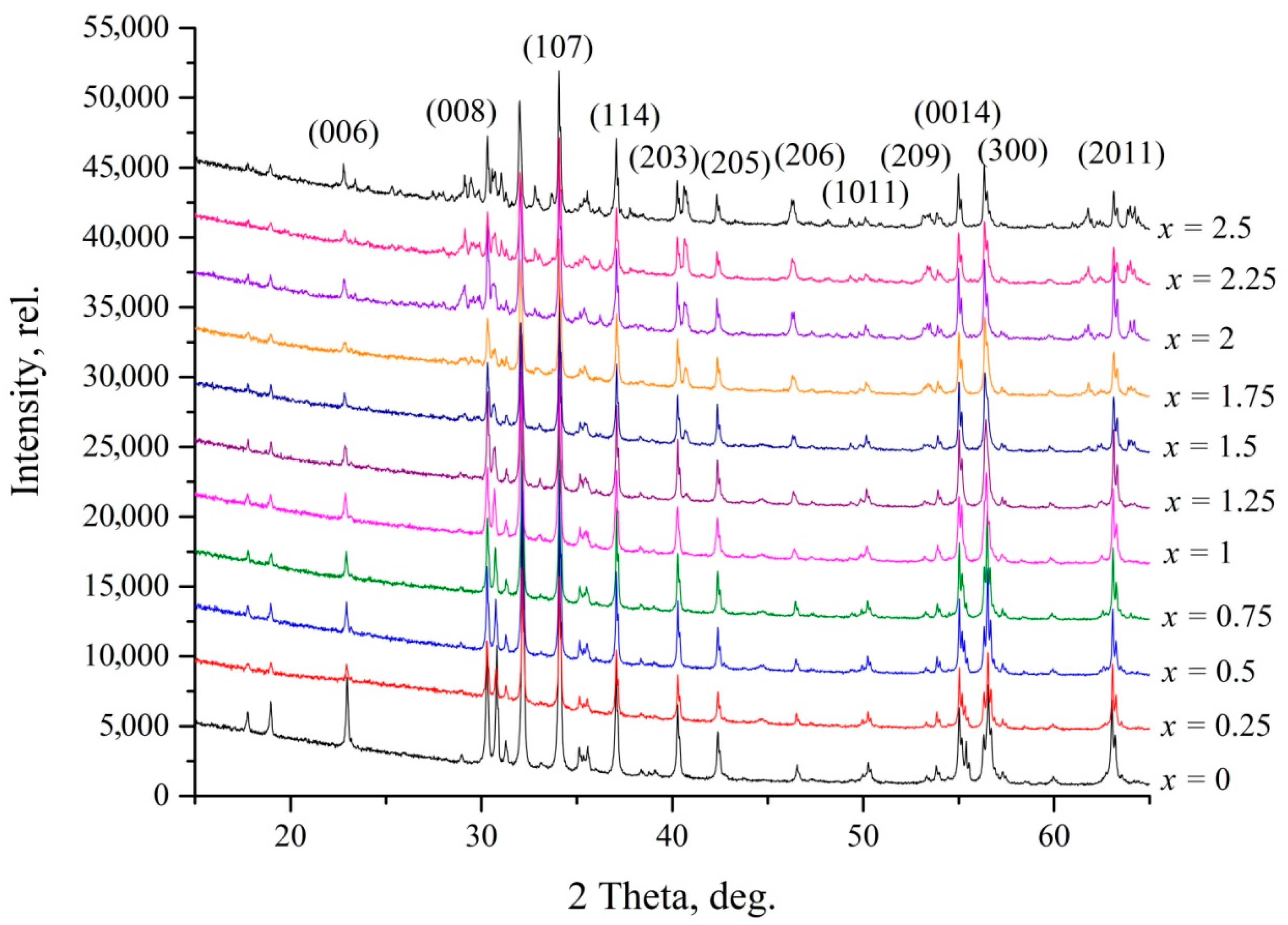

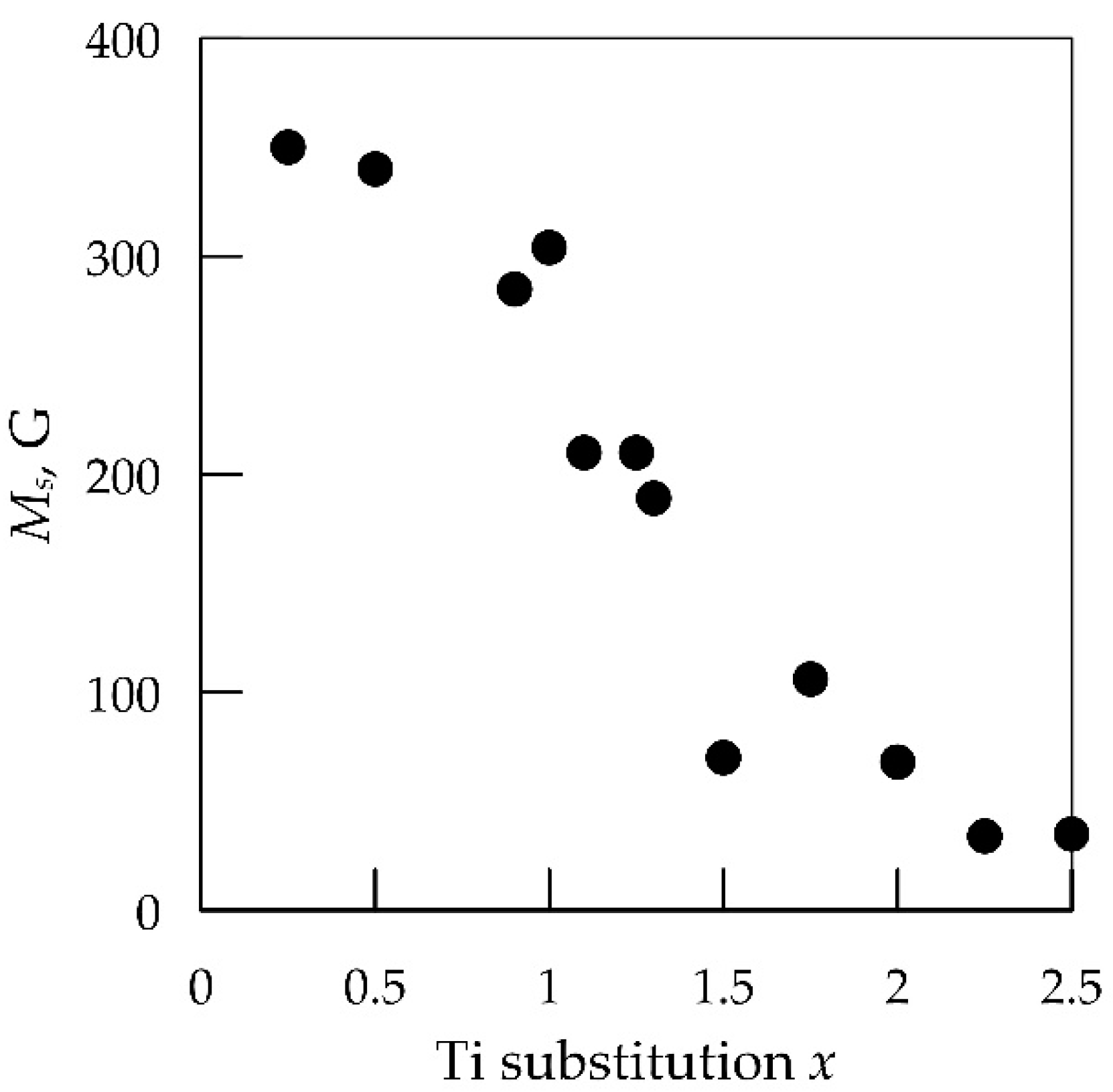

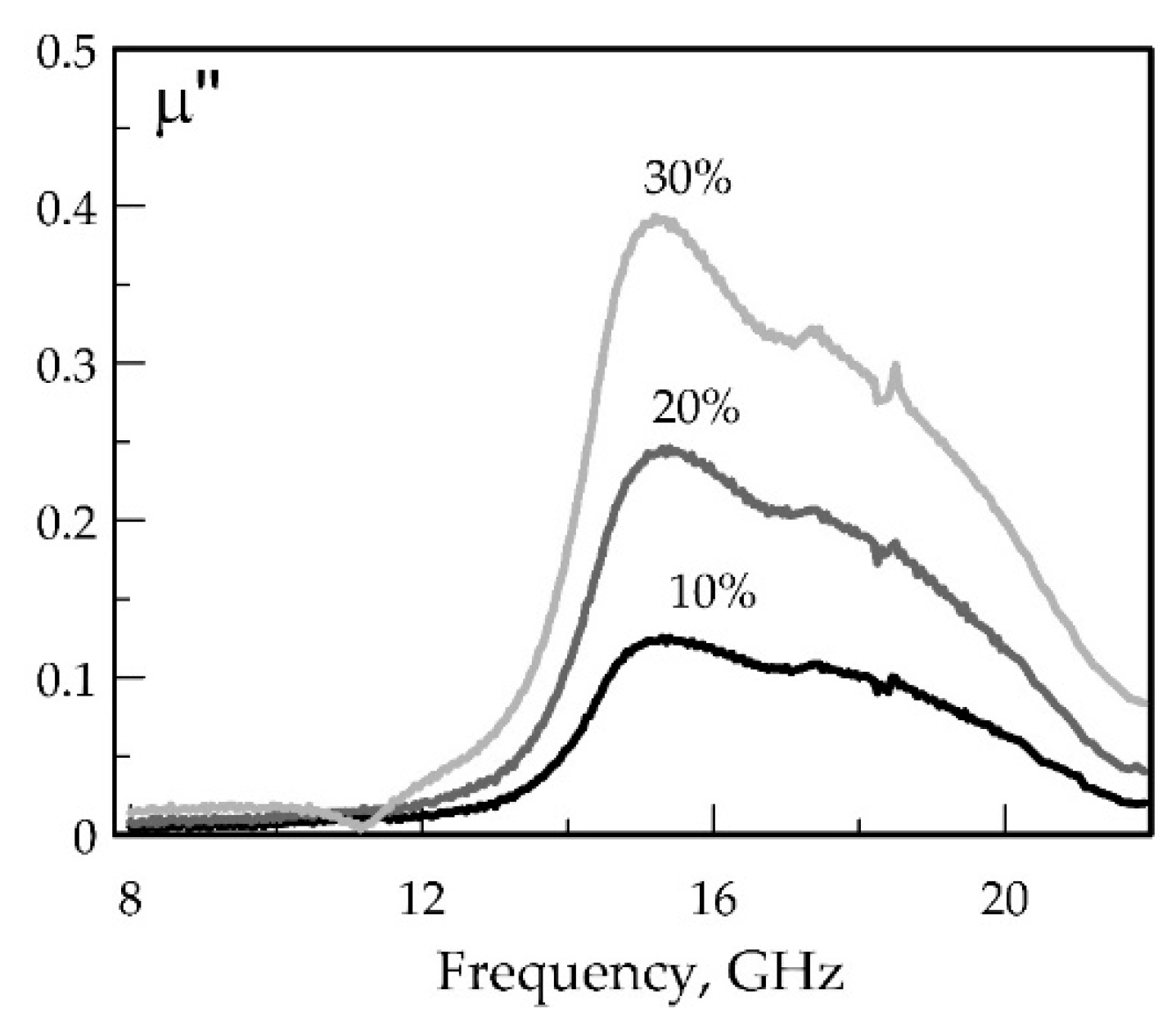
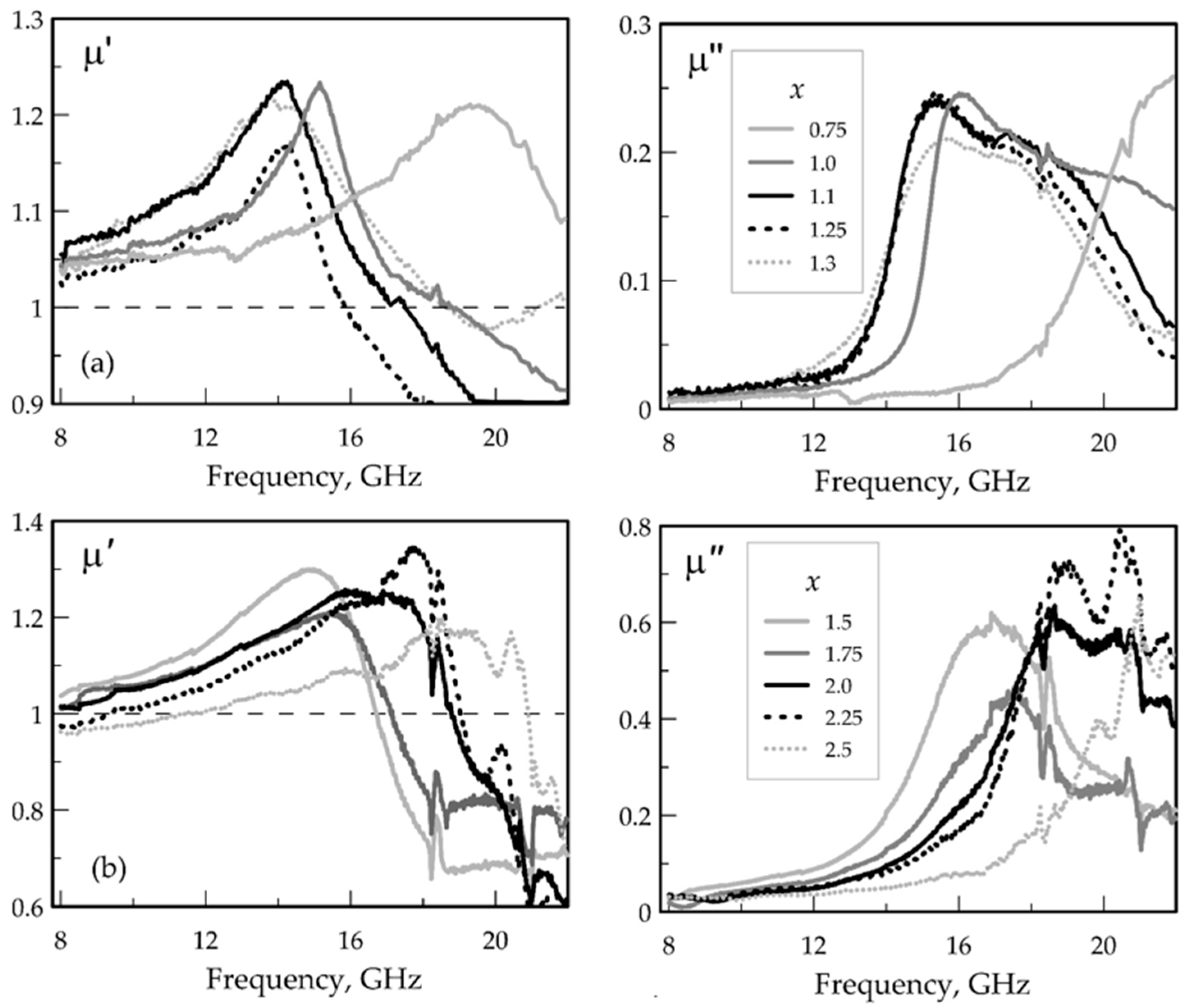

| Substitution Level x | Calculated Brutto Formula | a, Å | c, Å | V, Å3 |
|---|---|---|---|---|
| 0 | BaFe12O19 | 5.8934(4) | 23.2031(11) | 698.01(9) |
| 0.25 | BaFe11.72Ti0.28O19 | 5.8894(3) | 23.2183(9) | 697.44(6) |
| 0.5 | BaFe11.51Ti0.49O19 | 5.8888(4) | 23.2277(14) | 697.58(9) |
| 0.75 | BaFe11.26Ti0.74O19 | 5.8888(4) | 23.2546(13) | 698.39(9) |
| 1 | BaFe10.98Ti1.02O19 | 5.8868(5) | 23.2769(12) | 698.58(8) |
| 1.25 | BaFe10.72Ti1.28O19 | 5.8851(4) | 23.3035(13) | 698.96(9) |
| 1.5 | BaFe10.46Ti1.54O19 | 5.8855(4) | 23.3292(12) | 699.83(8) |
| 1.75 | BaFe10.28Ti1.72O19 | 5.8840(3) | 23.3128(13) | 698.98(8) |
| 2 | BaFe9.83Ti2.17O19 | 5.8823(3) | 23.3415(13) | 699.45(8) |
| 2.25 | BaFe9.69Ti2.31O19 | 5.8844(4) | 23.3411(13) | 699.94(8) |
| 2.5 | BaFe9.36Ti2.64O19 | 5.8842(4) | 23.3388(15) | 699.82(9) |
© 2020 by the authors. Licensee MDPI, Basel, Switzerland. This article is an open access article distributed under the terms and conditions of the Creative Commons Attribution (CC BY) license (http://creativecommons.org/licenses/by/4.0/).
Share and Cite
Zezyulina, P.A.; Petrov, D.A.; Rozanov, K.N.; Vinnik, D.A.; Maklakov, S.S.; Zhivulin, V.E.; Starikov, A.Y.; Sherstyuk, D.P.; Shannigrahi, S. Study of the Static and Microwave Magnetic Properties of Nanostructured BaFe12−xTixO19. Coatings 2020, 10, 789. https://doi.org/10.3390/coatings10080789
Zezyulina PA, Petrov DA, Rozanov KN, Vinnik DA, Maklakov SS, Zhivulin VE, Starikov AY, Sherstyuk DP, Shannigrahi S. Study of the Static and Microwave Magnetic Properties of Nanostructured BaFe12−xTixO19. Coatings. 2020; 10(8):789. https://doi.org/10.3390/coatings10080789
Chicago/Turabian StyleZezyulina, Polina A., Dmitry A. Petrov, Konstantin N. Rozanov, Denis A. Vinnik, Sergey S. Maklakov, Vladimir E. Zhivulin, Andrey Yu. Starikov, Daria P. Sherstyuk, and Santiranjan Shannigrahi. 2020. "Study of the Static and Microwave Magnetic Properties of Nanostructured BaFe12−xTixO19" Coatings 10, no. 8: 789. https://doi.org/10.3390/coatings10080789





